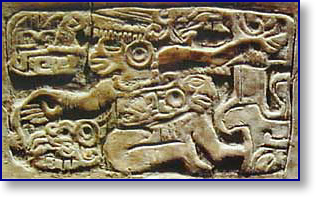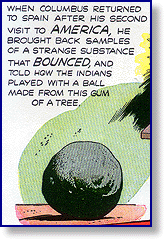
Destination Mexico:
Tlachtli
Main menu | PSLC | Next >Our expedition starts here in Mexico. We're in Tenochtitlan, capital of the Aztec Empire. Someday the world will know it as Mexico City. The year is about 1500, or 7-Acatl on the Aztec calendar. We're here to watch a game called tlachtli.
Tlachtli is kind of like basketball. Games similar to basketball have been played all over Mesoamerica by peoples like the Aztec, the Maya, and the Olmec. The object of Tlachtli is to put a ball through a hoop made of stone at one end of a court. But unlike basketball, the players can't use their hands. Also unlike basketball, where the losing team gets nothing worse than trash-talk from the winners, the losers in this game of tlachtli are going to have their heads chopped off after the game. The players are prisoners of war, the enemies of the Aztecs who are hosting the game. The game is a ritual honoring Amapan and Uappatzin, the patron deities of the game of tlachtli, and honoring Huitzilopochtli, the Aztec god of war.

Relief of a Maya ballplayer from Guatemala. Photo by
Nicholas Hellmuth. Courtesy of FLAAR Photo Archive,
http://www.maya-art-books.org.
But we're not here because of the gory post-game celebrations. We're interested in the ball these folks are playing with. It's roughly the size of a bowling ball, and weighs about five pounds. (Getting it through the hoop without using the hands is so hard that the first team to score a goal wins.) What's special about this ball is that it is made of natural rubber.

Cartoon of a tlachtli ball. Natural rubber is made by a number of plants which grow in warm climates. Of course, rubber balls aren't the only thing that the Aztec and other people of the Americas make from rubber. Rubber boots, raincoats of rubberized cotton cloth, and water bottles were all produced by the ingenuity of these people. Rubber was valuable enough in the world of ancient Mesoamerica that it was used to pay for goods and services in barter.
Ancient Mesoamerican ball
court in Monte Albán, Mexico.
Rubber is one of the Americas' best-kept secrets. But the rest of the world will find out about rubber eventually. Back in 1492 Christopher Columbus made his first visit to the West Indies. When he came back in 1496, he visited the island of Hispaniola. There he saw people playing games with rubber balls and was amazed at how well the rubber game balls bounced.
Aztec god Tlauixcalpantecuhtli burning a
rubber ball.
Rubber Goes on the Back Burner
More newcomers will follow Columbus. As violent as the Aztecs seem to us today, what with their human sacrifice and all, they are going to meet an even more violent group of people. Following Columbus to the Americas were the Spanish conquistadors. A group of conquistadors led by Hernan Cortes will land in Mexico in 1519 and incite a revolt of the oppressed Aztec subjects destroying the Aztec Empire. The subjects would have been better off under their old masters as the Spanish kill or enslave thousands. But the people which survive the tragedy will introduced the Spanish to the many wonderful uses of rubber.
In Europe no one has ever seen anything like rubber, and people there will be full of questions about it, questions like...what is this stuff?
Cartoon of Christopher Columbus
examining a rubber ball.
Next stop: Germany - Valence
Meanwhile...
While the people of Hispaniola are introducing Christopher Columbus to rubber, this is going on in the rest of the world:
c. 1500: In West Africa, the Kingdom of Dahomey reaches its height and begins trading slaves to Portuguese merchants.
1503: In Italy, Leonardo da Vinci paints the Mona Lisa.
1513: In Poland, Nicolas Copernicus proposes his theory that the earth moves around the sun.
For more information, at other websites...
Hevea brasiliensis:The Rubber Tree - the botany of the most important rubber-producing plant. An Ethnobotanical Leaflet from the Southern Illinois University Herbarium.
Morning Glories Go 'Boing'? - how Mayans used morning glories to make rubber more useful, from Wired.com.
Bibliography
1. (FREDERIKSEN, Thomas H.) STUDENT TEACHER RESOURCE CENTER (Aztec Religion - Aztec Gods) On-Line Student Resource Center: Humboldt Co. Ca.: (10 March 2000) http://northcoast.com/~spdtom/index.html
2. Aligned Lesson: The Aztec Game of Tlatchtli from Mexico - Jeffco Multicultural Lesson Plans, created by Jefferson County Public Schools, Jefferson County, Colorado.
3. Fenichell, Stephen. Plastic: The Making of a Synthetic Century. New York: HarperCollins, 1996.
Image credits
Relief of a Maya ballplayer from Guatemala: Photo by Nicholas Hellmuth, courtesy of FLAAR Photo Archive, http://www.maya-art-books.org/.
Cartoon of a tlachtli ball: From Wonder Book of Rubber, 1947, copyrighted material of The BFGoodrich Company reproduced with the permission of The BFGoodrich Company.
Ancient Mesoamerican ball court in Monte Albán, Mexico: Courtesy Dwaine and Lucy Eubanks.
Aztec god Tlauixcalpantecuhtli burning a rubber sphere: Copyright © 1994-2000 Thomas H. Frederiksen.
Cartoon of Christopher Columbus examining a rubber ball: From Wonder Book of Rubber, 1947, copyrighted material of The BFGoodrich Company reproduced with the permission of The BFGoodrich Company.
Copyright © 2002 - 2025 Polymer Science Learning Center
Work done by: Polymer Science Learning Center
and the Chemical Heritage Foundation